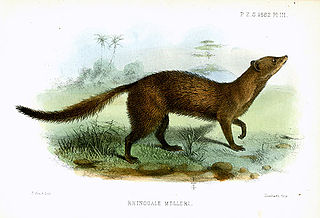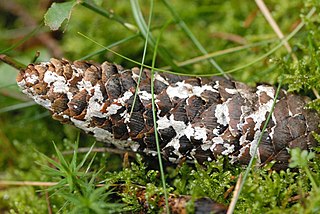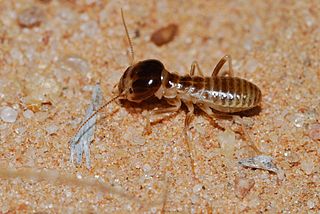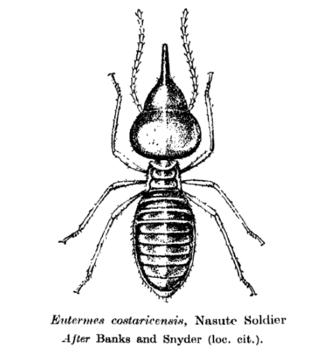Genus is a taxonomic rank used in the biological classification of living and fossil organisms as well as viruses. In the hierarchy of biological classification, genus comes above species and below family. In binomial nomenclature, the genus name forms the first part of the binomial species name for each species within the genus.

Termites are a group of detritophagous eusocial insects which consume a wide variety of decaying plant material, generally in the form of wood, leaf litter, and soil humus. They are distinguished by their moniliform antennae and the soft-bodied and often unpigmented worker caste for which they have been commonly termed "white ants"; however, they are not ants, to which they are distantly related. About 2,972 extant species are currently described, 2,105 of which are members of the family Termitidae.

Vespertilionidae is a family of microbats, of the order Chiroptera, flying, insect-eating mammals variously described as the common, vesper, or simple nosed bats. The vespertilionid family is the most diverse and widely distributed of bat families, specialised in many forms to occupy a range of habitats and ecological circumstances, and it is frequently observed or the subject of research. The facial features of the species are often simple, as they mainly rely on vocally emitted echolocation. The tails of the species are enclosed by the lower flight membranes between the legs. Over 300 species are distributed all over the world, on every continent except Antarctica. It owes its name to the genus Vespertilio, which takes its name from a word for bat, vespertilio, derived from the Latin term vesper meaning 'evening'; they are termed "evening bats" and were once referred to as "evening birds".

The numbat, also known as the noombat or walpurti, is an insectivorous marsupial. It is diurnal and its diet consists almost exclusively of termites.

The rove beetles are a family (Staphylinidae) of beetles, primarily distinguished by their short elytra that typically leave more than half of their abdominal segments exposed. With over 66,000 species in thousands of genera, the group is the largest family in the beetle order, and one of the largest families of organisms. It is an ancient group, with fossilized rove beetles known from the Triassic, 200 million years ago, and possibly even earlier if the genus Leehermania proves to be a member of this family. They are an ecologically and morphologically diverse group of beetles, and commonly encountered in terrestrial ecosystems.
Fibrobacterota is a small bacterial phylum which includes many of the major rumen bacteria, allowing for the degradation of plant-based cellulose in ruminant animals. Members of this phylum were categorized in other phyla. The genus Fibrobacter was removed from the genus Bacteroides in 1988.

Aphodiinae is a subfamily of the scarab beetle family, Scarabaeidae. Members of this subfamily are known commonly as the small dung beetles and many, but not all, are dung beetles. These beetles are found worldwide.

The Myrmecophagidae are a family of anteaters, the name being derived from the Ancient Greek words for 'ant' and 'eat'. Two genera and three species are in the family, consisting of the giant anteater, and the tamanduas. The fossil Eurotamandua from the Messel Pit in Germany may be an early anteater, but its status is currently debated.

Meller's mongoose is a small brown mongoose native to savannas and woodlands of southeastern Africa. It is the only member of the genus Rhynchogale. The Meller's mongoose lives alone and is active at night, feeding on termites or other small insects and animals. While somewhat rare, it is adaptable and faces no serious threats. It is a member of the mongoose family (Herpestidae), a group of fox-like animals native to Asia, southern Europe, and Africa.

Amitermitinae is a disputed subfamily of "higher termites" now often merged with the subfamily Termitinae and is considered by ITIS as a synonym; it had previously been placed in the family Rhinotermitidae.

Podaxis is a genus of secotioid fungi in the family Agaricaceae. Species, which have the appearance of a "stalked-puffball", have a worldwide distribution, and tend to be found growing solitary or scattered on sandy soils, especially in arid regions. Although close to 50 species have been described, it has been argued that many of them may represent extremes in the natural range of variations found in Podaxis pistillaris.

Atheliaceae is a family of corticioid fungi placed under the monotypic order Atheliales. Both the order and the family were described by Walter Jülich in 1981. According to a 2008 estimate, the family contains 20 genera and approximately 100 species. However, many genera formerly considered to belong in the Atheliaceae have since been moved to other families, including Amylocorticiaceae, Albatrellaceae, and Hygrophoraceae. Despite being a relatively small group with inconspicuous forms, Atheliaceae members show great diversity in life strategies and are widespread in distribution. Additionally, being a group strictly composed of corticioid fungi, they may also provide insights on the evolution of fruiting body forms in basidiomycetes.

Termitaphididae, occasionally called termite bugs, is a small tropicopolitan family of true bugs placed in the superfamily Aradoidea. Typically members of Termitaphididae are small, being an average of 2 millimetres (0.079 in)-4 millimetres (0.16 in), and flattened with laminae extending out from each body segment giving a round scale like appearance. Currently the family contains two genera and twelve known species. Members of Termitaphididae are inquilines lodging in the nests of host species of termite families Termitidae and Rhinotermitidae. Though considered a separate family in Aradoidea it has been suggested by Drs David Grimaldi and Michael Engel in 2008 that Termataphididae may in fact be highly derived members of Aradidae. Of the thirteen known species one Termitaphis circumvallata belongs to the monotypic genus Termitaphis and four of the remaining eleven species in Termitaradus are extinct, having only been found in amber. The living species are found worldwide in the tropical regions of Central and South America, Africa, Asia, and Australia.
The phylum Elusimicrobiota, previously known as "Termite Group 1", has been shown to be widespread in different ecosystems like marine environment, sewage sludge, contaminated sites and soils, and toxic wastes. The high abundance of Elusimicrobiota representatives is only seen for the lineage of symbionts found in termites and ants.

The Hodotermitidae are a basal Old World family of termites known as the harvester termites. They are distinguished by the serrated inner edge of their mandibles, and their functional compound eyes which are present in all castes. They forage for grass at night and during daylight hours, and the pigmented workers are often observed outside the nest. Their range includes the deserts and savannas of Africa, the Middle East, and Southwest Asia. Their English name refers to their habit of collecting grass, which is not unique to the family however.

Macrotermes is a genus of termites belonging to the subfamily Macrotermitinae and widely distributed throughout Africa and South-East Asia. Well-studied species include Macrotermes natalensis and M. bellicosus.

The Nasutitermitinae is a cosmopolitan subfamily of higher termites that includes more than 80 genera. They are most recognisable by the more highly derived soldier caste which exhibits vestigial mandibles and a protruding fontanellar process on the head from which they can "shoot" chemical weaponry. True workers of certain genera within this subfamily also exhibit a visible epicranial y suture, most notably found within the members of Nasutitermes. Notable genera include the notorious wood-eating Nasutitermes, and the conspicuous Hospitalitermes and Constrictotermes, both genera characterized by their behavior of forming large open-air foraging trails.

Termitinae is a subfamily of termites; Amitermes and certain other genera have previously been placed in the Amitermitinae, with some workers arguing that the latter have morphologically distinct characteristics and "some important attributes that affect soil".

Zootermopsis laticeps, known generally as Arizona dampwood termite, is a species of termite in the family Archotermopsidae. Other common names include the wide-headed rottenwood termite and southwestern rottenwood termite. It is found in arid parts of south-western North America.

Hospitalitermes is an Asian–Papuan genus of lichen-eating termite in the subfamily Nasutitermitinae. There are 37 species currently listed, of which most are recognized for their extensive surface foraging columns. Due to their conspicuous foraging activities, they are commonly known as processionary or marching termites. They often inhabit cavities inside of living trees excavated by other species of termite.

















